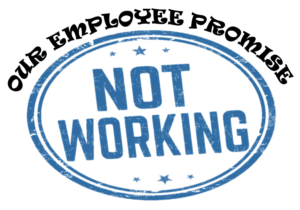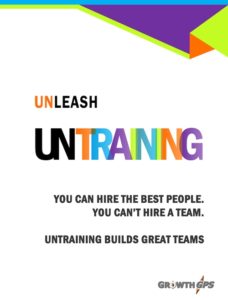Strong leaders share great stories about their organizations. Great stories capture listeners’ attention by stirring our emotions with unexpected details. We remember great stories and tell others about them. We’re not all great storytellers, but with the right content, you’re on the way.
We coach leaders to develop provocative content that commands listeners’ attention.
▶ Brainstorming better story content leads to ideas for organizational change.
Most leaders have well-honed stories to share with customers, investors, shareholders, and even community leaders. We hear what makes their company’s products second to none, their financials the envy of competitors, and the great ways in which they serve the local community.
▶ Often the Recruiting Story – designed to answer “Why you should want to join us” – comes up short on content.
In today’s talent-short environment with 2 job openings for every individual looking for work, a compelling Recruiting Story is perhaps your most important story of all. A captivating employee experience story is proving to win the ear of shareholders, investors and community leaders alike.
Enjoy this Recruiting Story about NOTWorking
I’d like to tell you how the pandemic changed me as a leader, changed our management team and changed our company. Before you think something like “I’ve heard this story before, the pains of lockdown and shutdown, and then the agony of re-start.” Well, you’d be right, but what we learned and discovered is newsworthy, especially with today’s extreme employee turnover. Would I have your attention if I told you not a single employee has left our company since the pandemic started?
When everyone first worked from home, I found myself calling the 11 guys on my team a couple times a day, sometimes more to coordinate a tough project we were trying to keep on time. We were equally excited when IT launched a new videoconferencing and file sharing platform, figuring the coordination would get easier and we’d enjoy seeing each other instead of just talking. That led to a surprise I never expected: we talked less and it was strictly business.
We talked regularly at first, I got to know people on a personal basis that we rarely experienced before. I learned about their families, their interests, and I got to know what they really liked about working at our company. Trust me, I got an earful about things we could do better. At first that really bothered me, then I realized I was onto something. I heard the unfiltered truth from the guys. We weren’t in the office, so it seemed they weren’t holding back. They told me things like a friend instead of treating me like a boss. Things like –
- Talking like this is the first I’ve gotten to know you outside work
- It seems when we’re at work there’s no way to share what I’m thinking like we’re doing now
- I’ve got lots of ideas to make life at work better like the one we just talked about; when we go back how do I get to share my ideas?
- I’ve gotten to know people in our group really well on these calls. Any ideas for how I can get to know people in other departments?
- We work a lot with Engineering, I’d like to get to know those guys better. Is there any chance you could put me on a project with them?
I heard lots of comments along those same lines – people saying they didn’t have an opportunity to meet people in other groups, or to share their ideas, or to work on projects outside our group. I took this into a management meeting and the more I talked, the more heads nodded. Turns out my colleagues were hearing the same thing.
How could we solve this and be a better company?
As a management team, we asked ourselves how we could address some of these concerns now and after returning to the office. Our a-ha was realizing we’d become more isolated in our department “silos” than before, when we’d at least grab a coffee or lunch together. It was our relationships with each other we leaned on for the kind of camaraderie to get through the tough challenges of the pandemic.
We focused on brainstorming a way employees could meet each other while working from home, especially those in other departments. For everyone to participate, it needed to work equally well for newer and longer-term employees. While our longer-term employees knew more people around the company, we needed a way for them to meet the newer employees just as much as we needed newer employees to meet just about everybody.
Our idea took shape when our head of Finance said she’d been networking with peers and she enjoyed swapping stories. Fran described her networking as a new support group, a way of coping with the turbulent times and unpredictable financial challenges brought about by the shutdown. Fran’s enthusiasm about this surprised me, because she’s usually the quiet one out of all of us. Fran offered that if we could do something to take the first-meet jitters out of it and avoid investing more time that none of us have, she’d be on board.
Jackpot! We could arrange networking meetings between employees using Teams, scheduled with calendar invites during normal work hours. We figured if we arranged 2 networking meetings every week between employees, over a full year everyone would meet about 100 fellow employees from all around the company. These could be something to look forward to, a break in the day, and by scheduling them on everyone’s calendars, other meetings would get booked around them so they shouldn’t get cancelled. An investment of 2 hours a week for every employee was well worth it if we could boost morale during the pandemic.
We needed a name
We wanted it to be fun and to play off the networking concept. We called it Notworking, figuring that subject on our calendars would win attention.
We arranged a week’s worth of Notworking events, inviting pairs of employees we figured likely didn’t know each other. We didn’t anticipate some bad feedback, like those paired with an exec said they felt stressed about it and took time to prepare. Exactly opposite of the spontaneous fun we aimed for! Our IT team found a way to send calendar invites without participants able to see who they’d be networking with. That solved it. IT also developed an automated tool to pair people for Notworking, making sure people weren’t paired-up twice, while randomizing pairings across departments and levels.
Our quarterly employee pulse survey proves how well Notworking works. Scores for connection, confidence and trust are at all-time highs for our company, something we’re all proud of because it supports the collaborative culture we’re building. From a business perspective, I’m even more proud that not a single employee chose to leave since we launched Notworking, while other firms our size experienced 25% and higher turnover. Our pulse scores keep rising with Notworking now in its third year, a sign we’re on the right track with employees.
Powerful Recruiting Tool
Notworking has become a powerful Recruiting and Hiring tool. Sure, we’re competitive on pay and benefits, but today’s best expect more. We enjoy telling candidates they’ll get to meet 100 fellow employees during their first year, not as part of work but as part of Notworking. In fact, we’ve doubled our interview-to-hire ratio with Notworking.
today’s best expect more. We enjoy telling candidates they’ll get to meet 100 fellow employees during their first year, not as part of work but as part of Notworking. In fact, we’ve doubled our interview-to-hire ratio with Notworking.
Imagine how candidates react during an interview when we ask if they’d be comfortable joining our Notworking program! That’s a whole other set of stories I’ll share another time.
Great story? We think so!
We’re proud to have helped the client who wrote this story break through the talent challenge. Of the 10 stories every leader should know, this company’s Recruiting story was the weakest. With our help, the Recruiting story is now their strongest story in content. More importantly, it’s the strongest story for business impact. The numbers the executive shared in the story are on pace to save the firm over $1 million annually.



